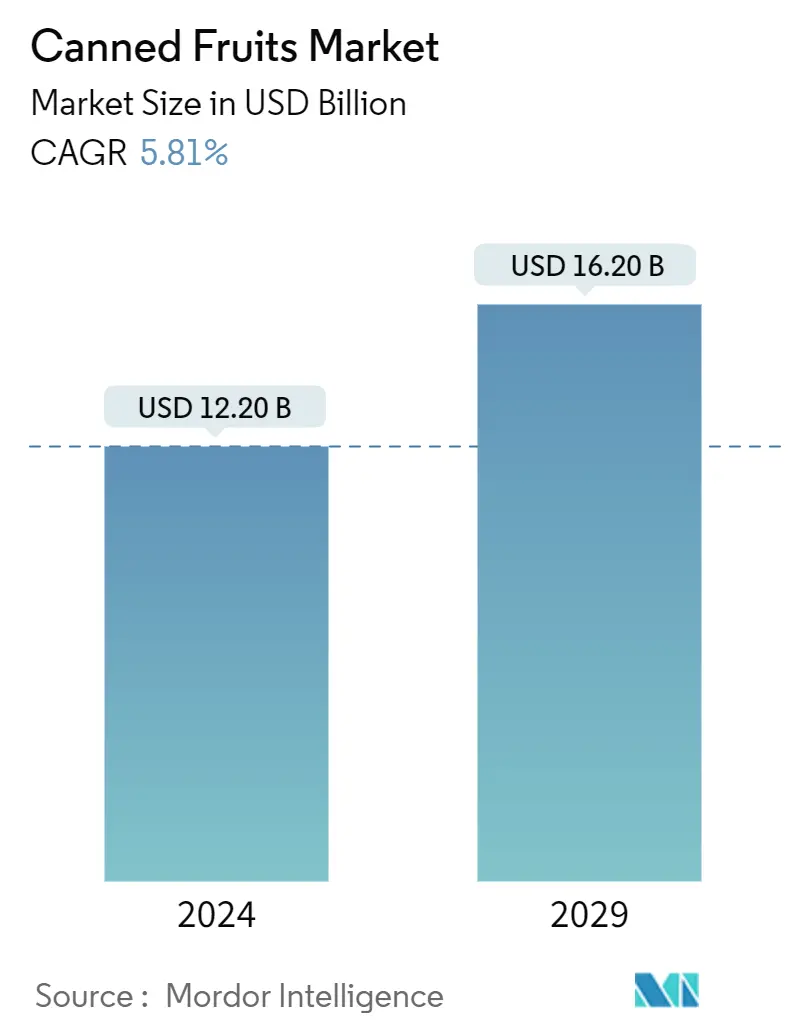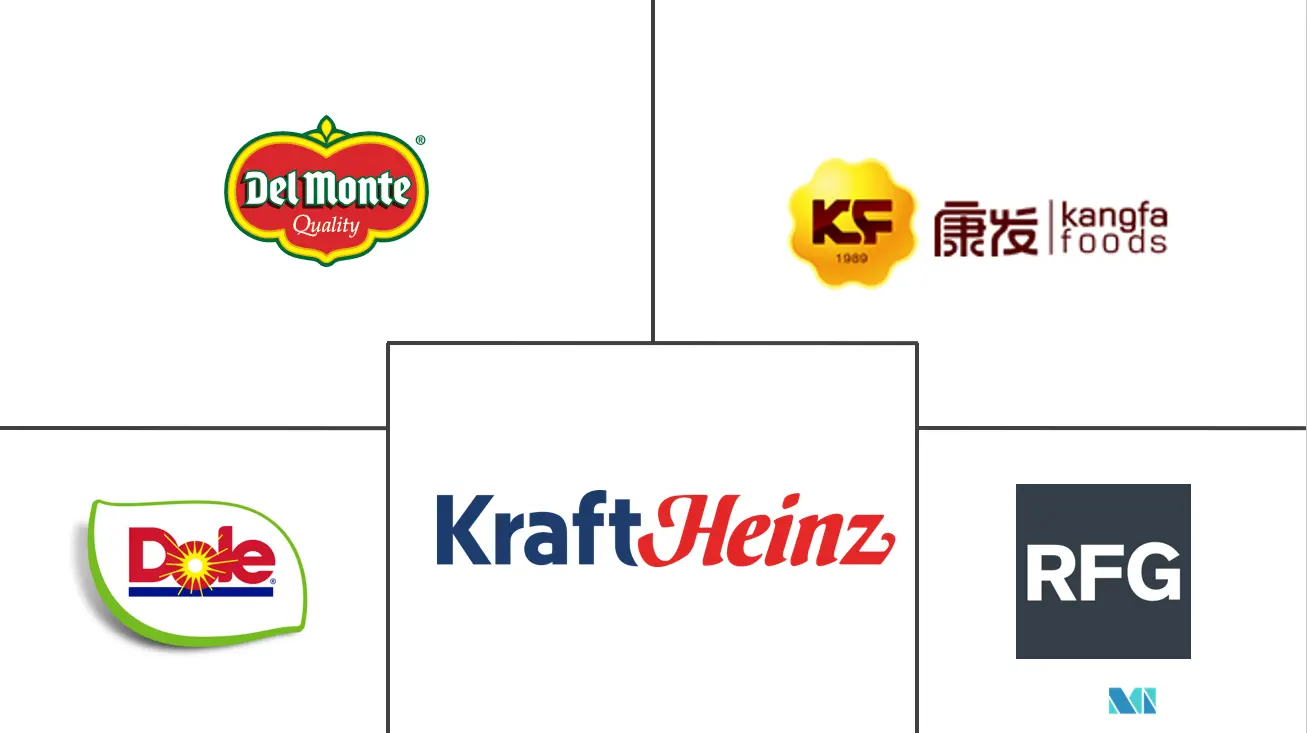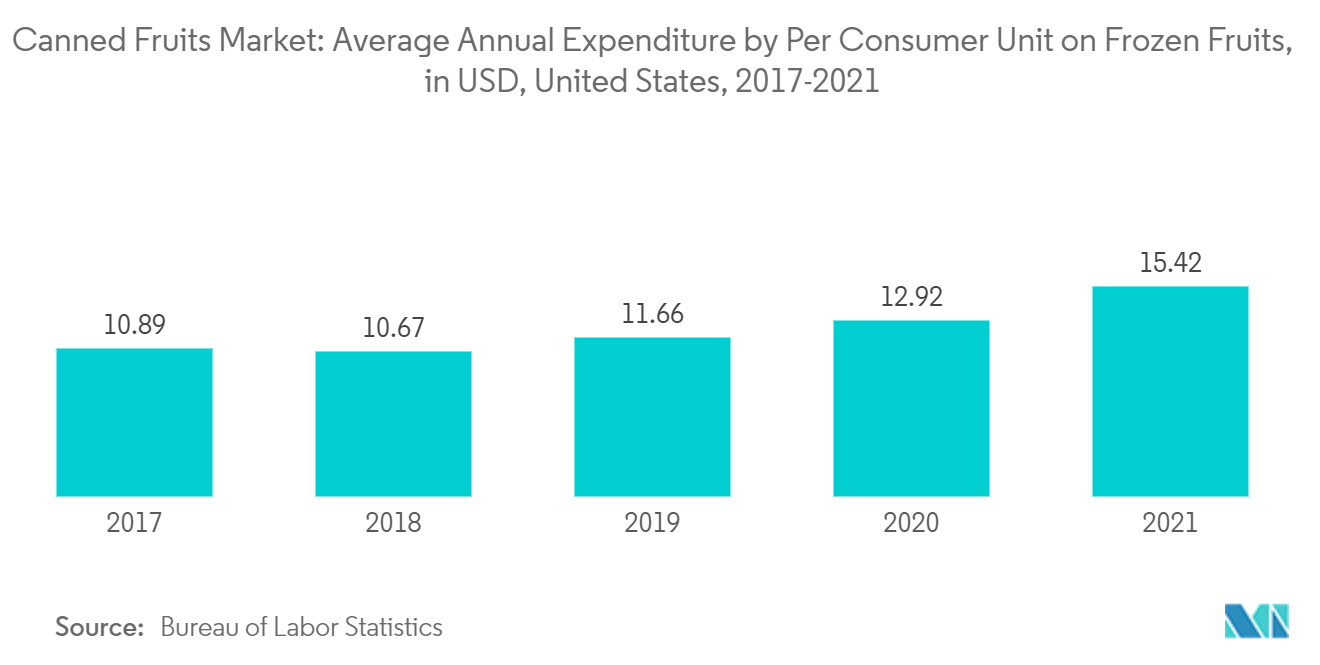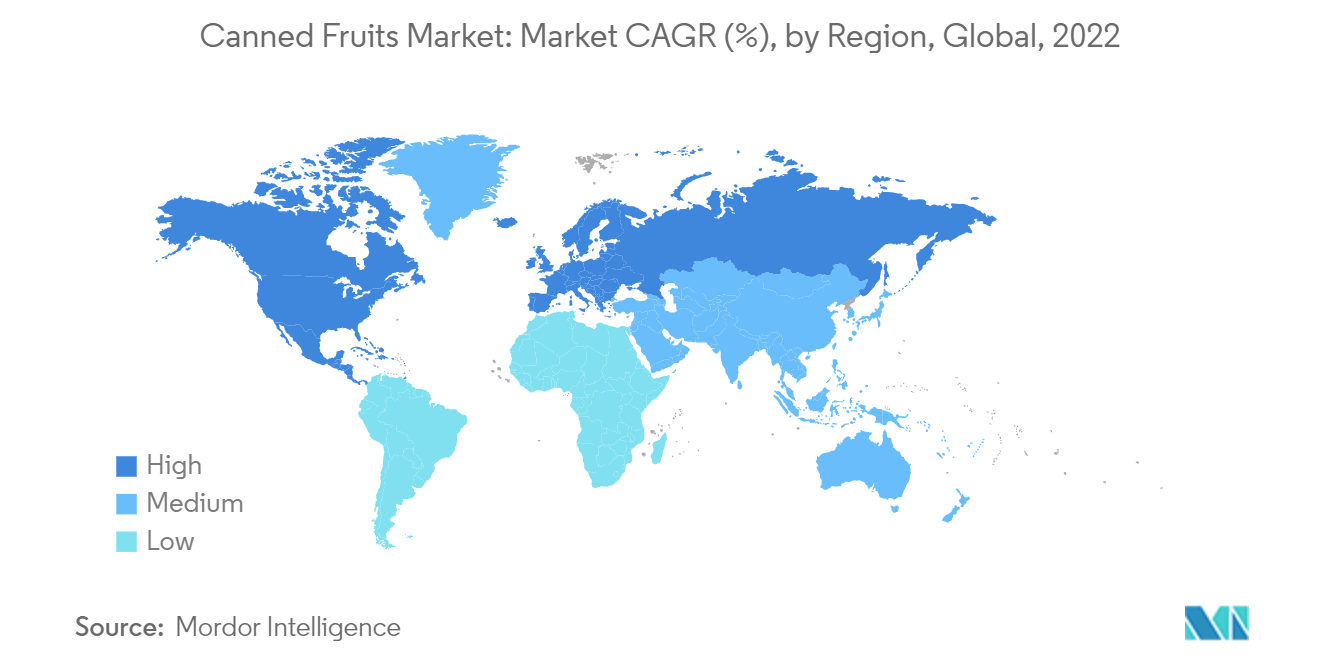Canned Fruit Market Size

| Study Period | 2019 - 2029 |
| Market Size (2024) | USD 12.20 Billion |
| Market Size (2029) | USD 16.20 Billion |
| CAGR (2024 - 2029) | 5.81 % |
| Fastest Growing Market | Asia Pacific |
| Largest Market | North America |
Major Players
*Disclaimer: Major Players sorted in no particular order |
Canned Fruit Market Analysis
The Canned Fruits Market size is estimated at USD 12.20 billion in 2024, and is expected to reach USD 16.20 billion by 2029, growing at a CAGR of 5.81% during the forecast period (2024-2029).
- The primary factors driving the anticipated market growth are developments that advance canning technology. Increased research and development spending is associated with the production of healthier foods, improved "Nutri-score" labels, and a wider range of convenience products. The market will expand as a result of the developing distribution network for canned goods across the globe. Consider offline and online retailers that specialize in a niche or specialty food markets, such as Asian, Halal, vegan, organic, etc. The market for canned fruits and vegetables is still heavily influenced by the long shelf life of these products.
- Prices have a big impact on what people spend on food, which ultimately helps to explain some of the trends in the food marketing industry. Low-income individuals like to shop at low-cost shops/outlets and frequently purchase less expensive foods. Private-label manufacturers dominate this category since they are generally offered at lower prices than branded or big players. These goods have long been easily accessible in supermarkets and other retail stores. As a result, mass market outlets are seeing an increase in sales as producers continue to release low-cost canned goods in large quantities.
- Canned fruits require a specific environment of storage and unwanted complications occur if the product is exposed to incompatible conditions. This mostly happens if the contents are not being consumed in a short time once the can is opened. Nevertheless, secondary plastic lids are being considered as a remedy to tackle enzymatic reactions that lead to spoilage.
Canned Fruit Market Trends
Growing Consumer Preference Towards Fresh, Convenient Fruits Offering
The market for canned fruit has been considerably impacted by a constant increase in the consumption of fresh and minimally processed fruit. Therefore, major brand manufacturers are shifting to minimally processed fruits as product line extensions of canned fruits and repositioning and repackaging their products accordingly. To increase sales, bulk cans of fruit could be introduced and distributed through mass merchandisers and low-cost food retailers.
Manufacturers aim to increase sales of canned fruits as a healthy snack and position them as low-sugar products that the consumer will perceive as safe. According to the Centers for Disease Control and Prevention, only 10% of adults ate enough fruits or vegetables due to high cost, limited availability, and access, or perceived lack of preparation time. However, canned food is much more affordable, nutritious, with great taste, and highly convenient. Additionally, growing consumer awareness of canned fruit consumption might a key driver for the growth of canned fruit.

Asia Pacific Canned Fruits Market is the Progressing Rapidly
With the transformation of society in the Asia Pacific region, the demand for processed foods is rising. The fast-moving lifestyle and continuously increasing population is the primary reason for the inflated demand for ready-to-eat foods. Moreover, with the increasing demand for processed foods, there is a need to develop healthier solutions with sustained shelf-life. Canned fruits turn out to be the best remedy for all applications requiring fruit pieces due to their easy handling and ready-to-utilize facility. With the progressing food industry in China, the demand for canned fruits is rising for versatile applications. India is also witnessing a similar boom due to the growing inclination of people towards fruit cakes and fruit bread. The demand for canned fruits is rising, especially in the bakery industry, as the fruit bits with absorbed syrup tend to provide an undoubtedly fresh and sweet taste, contrary to fresh fruit pieces, which might turn out bitter on rare occasions.

Canned Fruit Industry Overview
Food safety has always been and remains a top priority for every company. Abiding with this, the leading players promise to provide customers with the freshest, safest, and highest-quality fruit. The introduction of hi-technology machines, including new optical color and laser sorters, custom-designed pitting and processing lines, high-speed packaging lines, and on-site freezing and frozen storage, have further made it convenient to process fruits in a better manner. With the adoption of various strategies for market expansion, Dole Food Company, Del Monte Food Inc., Rhodes Food Group, and Kraft Heinz Company are some of the major payers of the canned fruits market.
Canned Fruit Market Leaders
-
The Kraft Heinz Company
-
Del Monte Food, Inc
-
Dole Food Company
-
Rhodes Food Group
-
Kangfa Foods
*Disclaimer: Major Players sorted in no particular order

Canned Fruit Market News
In 2022, Dole plc launched a new specialist for exotic fruits such as Dole Exotics and BE Exotic at Fruit Logistica 2022, Europe's premier fresh produce trade show. The company strives to deliver points of difference to exotic fruits through Dole bananas and pineapples across Europe and the rest of the world.
In 2021, Del Monte Food, Inc has collaborated with Iceland and The Food Warehouse Stores, an online store to launch Del Monte frozen fruit range. To meet the growing demand from the customers the company launched a wide range of frozen fruit range which includes Del Monte frozen raspberries, and Dal Monte frozen blueberries.
In 2021, Aconcagua Foods, a subsidiary of La Costeña expanded its operation in Chile by making a purchase of 60% of the peaches harvested and also launched a wide range of products from Mexico to the local market of Chile.
Canned Fruit Market Report - Table of Contents
1. INTRODUCTION
- 1.1 Study Assumptions and Market Definition
- 1.2 Scope of the Study
2. RESEARCH METHODOLOGY
3. EXECUTIVE SUMMARY
4. MARKET DYNAMICS
- 4.1 Market Drivers
- 4.2 Market Restraints
-
4.3 Porter's Five Forces Analysis
- 4.3.1 Threat of New Entrants
- 4.3.2 Bargaining Power of Buyers/Consumers
- 4.3.3 Bargaining Power of Suppliers
- 4.3.4 Threat of Substitute Products
- 4.3.5 Intensity of Competitive Rivalry
5. MARKET SEGMENTATION
-
5.1 Fruit Type
- 5.1.1 Peaches
- 5.1.2 Pineapple
- 5.1.3 Mandarin oranges
- 5.1.4 Pears
- 5.1.5 Other Fruit Types
-
5.2 Form
- 5.2.1 Whole fruits
- 5.2.2 Cut fruits
-
5.3 Distribution Channel
- 5.3.1 Supermarkets/Hypermarkets
- 5.3.2 Convenience Stores
- 5.3.3 Online Retail Stores
- 5.3.4 Other Distribution Channels
-
5.4 Geography
- 5.4.1 North America
- 5.4.1.1 United States
- 5.4.1.2 Canada
- 5.4.1.3 Mexico
- 5.4.1.4 Rest of North America
- 5.4.2 Europe
- 5.4.2.1 Spain
- 5.4.2.2 United Kingdom
- 5.4.2.3 Germany
- 5.4.2.4 France
- 5.4.2.5 Italy
- 5.4.2.6 Russia
- 5.4.2.7 Rest of Europe
- 5.4.3 Asia Pacific
- 5.4.3.1 China
- 5.4.3.2 Japan
- 5.4.3.3 India
- 5.4.3.4 Australia
- 5.4.3.5 Rest of Asia-Pacific
- 5.4.4 South America
- 5.4.4.1 Brazil
- 5.4.4.2 Argentina
- 5.4.4.3 Rest of South America
- 5.4.5 Middle-East and Africa
- 5.4.5.1 South Africa
- 5.4.5.2 Saudi Arabia
- 5.4.5.3 Rest of Middle-East and Africa
6. COMPETITIVE LANDSCAPE
- 6.1 Strategies Adopted by Leading Players
- 6.2 Market Share Analysis
-
6.3 Company Profiles
- 6.3.1 Dole PLC
- 6.3.2 The Kraft Heinz Company
- 6.3.3 Del Monte Food Inc.
- 6.3.4 Rhodes Food Group
- 6.3.5 Roland Foods
- 6.3.6 Seneca Foods
- 6.3.7 Xiamen Gulong Group Co., Ltd
- 6.3.8 Kangfa Foods
- 6.3.9 CHB Group
- 6.3.10 Delicia Foods India Pvt. Ltd.
- *List Not Exhaustive
7. MARKET OPPORTUNITIES AND FUTURE TRENDS
** Subject To AvailablityCanned Fruit Industry Segmentation
Canned fruits are products prepared from fresh, frozen fruits following the thermal process, or processed by another physical method. Depending on the product type, the products go for various operations such as washing, peeling, coring, stemming, grading, cutting, etc. The canned fruits market is segmented into fruit types, form, distribution channels, and geography. By fruit type, the market is segmented into peaches, pineapple, mandarin oranges, pears, and others. Based on the form, the market is classified into whole fruits and cut fruits. Based on distribution channels, the market is segmented into supermarkets/hypermarkets, convenience stores, online retail stores, and other distribution channels. The market has also been studied by geography under North America, Europe, Asia Pacific, South America, and the Middle East and Africa regions. For each segment, the market sizing and forecasts have been done on the basis of value (in USD million).
| Fruit Type | Peaches | |
| Pineapple | ||
| Mandarin oranges | ||
| Pears | ||
| Other Fruit Types | ||
| Form | Whole fruits | |
| Cut fruits | ||
| Distribution Channel | Supermarkets/Hypermarkets | |
| Convenience Stores | ||
| Online Retail Stores | ||
| Other Distribution Channels | ||
| Geography | North America | United States |
| Canada | ||
| Mexico | ||
| Rest of North America | ||
| Geography | Europe | Spain |
| United Kingdom | ||
| Germany | ||
| France | ||
| Italy | ||
| Russia | ||
| Rest of Europe | ||
| Geography | Asia Pacific | China |
| Japan | ||
| India | ||
| Australia | ||
| Rest of Asia-Pacific | ||
| Geography | South America | Brazil |
| Argentina | ||
| Rest of South America | ||
| Geography | Middle-East and Africa | South Africa |
| Saudi Arabia | ||
| Rest of Middle-East and Africa |
Canned Fruit Market Research FAQs
How big is the Canned Fruits Market?
The Canned Fruits Market size is expected to reach USD 12.20 billion in 2024 and grow at a CAGR of 5.81% to reach USD 16.20 billion by 2029.
What is the current Canned Fruits Market size?
In 2024, the Canned Fruits Market size is expected to reach USD 12.20 billion.
Who are the key players in Canned Fruits Market?
The Kraft Heinz Company, Del Monte Food, Inc, Dole Food Company, Rhodes Food Group and Kangfa Foods are the major companies operating in the Canned Fruits Market.
Which is the fastest growing region in Canned Fruits Market?
Asia Pacific is estimated to grow at the highest CAGR over the forecast period (2024-2029).
Which region has the biggest share in Canned Fruits Market?
In 2024, the North America accounts for the largest market share in Canned Fruits Market.
Canned Fruits Industry Report
The global canned fruit market is segmented by fruit type, form, distribution channel, and geography. The market includes peaches, pineapple, mandarin oranges, pears, and other fruit types. The forms of canned fruits are whole fruits and cut fruits. The distribution channels include supermarkets/hypermarkets, convenience stores, online retail stores, and other distribution channels. The market spans across North America, Europe, Asia Pacific, South America, and the Middle East & Africa.
The market analysis provides an industry overview, highlighting the industry trends and market trends that are driving growth. The market size and market share are covered, offering a comprehensive market forecast and market outlook. The industry report includes industry statistics and industry research, which are crucial for understanding market growth and market predictions.
The industry analysis delves into the market segmentation and market value, offering detailed insights into market data. The market report also covers the market review, providing a thorough examination of market leaders and their contributions to the market growth. The industry information includes industry sales and industry size, which are essential for understanding the overall market landscape.
The report example is available as a report PDF, allowing for an in-depth examination of the market forecast and market overview. The industry outlook and market outlook are discussed, providing a future perspective on the market trends. The industry reports and research companies involved in the market are also highlighted, ensuring a comprehensive understanding of the market dynamics.



